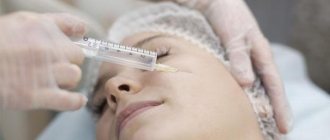The plasmolifting procedure in gynecology, reviews of which will be presented in this article, is a therapeutic measure, the purpose of which is to strengthen the general health of a woman, eliminate a number of gynecological ailments, normalize the condition of the mucous membrane of the genital organs, maintain the tone of the smooth, striated muscles of the small organs pelvis This procedure is considered non-surgical and is often included in a complex of therapeutic measures to restore tissue structure. Reviews about plasma lifting in gynecology from specialists indicate that the procedure may be one of the methods of anti-inflammatory treatment. Let's talk about it in more detail.
Advantages
The main advantage of plasma lifting is the safety of the method, because the body’s own interstitial fluid is used as the main material.
Other positive aspects of plasma lifting in gynecology are listed below:
- There is no individual intolerance to the administered biocomponents and no risk of an allergic reaction.
- A small number of contraindications (they will be presented below).
- The ability to get rid of a gynecological disease and reduce the likelihood of its relapse.
- Activation of the immune system.
- Elimination of inflammatory processes in the body.
- Improving microcirculation (in the system of lymphatic and blood capillaries).
- Normalization of metabolism, achievement of homeostasis (constancy of the internal environment in the body).
- Improving the contractility of the pelvic floor muscle tissue.
- Getting rid of diseases of bacterial etiology in a woman’s body.
- Restoration of the mucous membrane of the female genital organs (cervix, uterus, fallopian tubes, vagina and cervical canal).
- Relief from vaginal dryness.
- General improvement in the quality of sexual life.
All these advantages of the procedure have been proven more than once by reviews of plasma lifting. In gynecology, such procedures are quite in demand.
How is the procedure performed?
After a comprehensive diagnosis, a blood sample of 30-60 ml is taken from the woman (depending on the purpose of treatment). The test tube with the biomaterial is placed in a centrifuge to separate the serum. At the end of the process, clearly defined three layers are visible in the test tube. For therapeutic purposes, the middle fraction (enriched plasma) is used; it is drawn into a syringe.
Hospitalization is not required to perform the manipulation. The injections are given in the doctor's office, after which the patient can go home.
Preparation
Blood sampling is carried out on an empty stomach, preferably in the morning. If treatment is prescribed in the afternoon, the last meal should be no later than 4 hours before the injection. For 1-2 days, you must avoid drinking any alcoholic beverages, regardless of their strength.
Methodology
Plasmolifting of the intimate zone is the injection of autoplasma into damaged areas of soft tissues and mucous membranes. Local anesthesia is not required. By means of microinjections, the drug is distributed in the area of the inflammatory or destructive focus. In individual cases, an anesthetic spray may be used.
Injections are given subcutaneously or into the mucous membrane of the reproductive organs (cervix, vagina, endometrium). To administer plasma, needles of minimal diameter are used. The distance between punctures is at least 1 cm.
Rehabilitation period
Plasmolifting does not require long-term rehabilitation. To avoid infection of the puncture sites, it is not recommended to take a bath or visit the pool or sauna for 3 days after the procedure. It is also better to refrain from intimacy.
Indications for use
When is it necessary to start plasma lifting? Reviews in gynecology from qualified doctors indicate that the procedure is prescribed in the following cases:
- The presence of an affected area on the genitals.
- The need to eliminate inflammatory processes.
- Treatment of endometritis - inflammation of the endometrium, that is, the inner lining of the uterus.
- Kraurosis of the vulva, which is atrophy of the mucous membrane of the external female reproductive organs.
- Leukoplakia of the cervix, which is a pathological process of keratinization, thickening of epithelial tissue.
- Treatment of adnexitis, that is, an inflammatory process that develops in the ovaries.
- Inflammatory process in the vaginal mucosa (vaginitis).
- Cracks in the vulvar mucosa.
- Discomfort due to excessive vaginal dryness (in most cases, a symptom characteristic of women during menopause).
Is it safe?
What does this method help achieve for gynecological problems? The operation is suitable for patients experiencing complexes due to the appearance of the genital organs, suffering from discomfort due to:
- postpartum ruptures, previous operations or injuries, with asymmetry of the labia;
- dry mucous membranes;
- lipodystrophy of the labia and degeneration of the vaginal mucosa;
- it is also suitable for the complex treatment of inflammation and diseases of the genital organs, such as inflammation of the cervix (cervitis), the uterus itself (endometritis), leukoplaxia of the cervix or caruosis of the vulva;
disorders of the vaginal microflora;- for patients dissatisfied with the aging of the skin of the penis;
- those suffering from erectile dysfunction or Peyronie's disease (curvature of the penis when achieving an erection).
Prices for plasma lifting in Moscow:
- plasma lifting of the cervix will cost the patient 3,000 rubles;
- vulva - 3000 rub;
- endometrial plasma lifting - 4000 rubles;
- penis will cost from 5,000 to 6,000 rubles.
Prices for this operation in Moscow and St. Petersburg do not differ significantly. The cost of the procedure also includes an examination by a gynecologist and relevant tests.
There are contraindications:
- positive reaction to sodium anticoagulant;
- pregnancy and lactation;
- oncology;
- acute infection;
- acute chronic diseases;
- autoimmune diseases;
- hemophilia;
- exacerbation of herpes infection;
- mental illness;
- platelet disorders.
Contraindications to plasma lifting
Reviews about the procedure given by patients prove that plasma lifting is simply irreplaceable in the fight against many problems. However, it is also necessary to take into account some contraindications for the procedure.
There are factors that interfere with plasma lifting treatment. These include the following:
- Pregnancy and lactation period.
- Rejection of the functional layer of the uterus (during menstruation).
- Diseases associated with poor blood clotting.
- The presence of infectious diseases in a woman, as well as exacerbation of the inflammatory process.
- The patient's intolerance to the enzyme heparin and other anticoagulants (anticoagulants).
- Oncological diseases of the female reproductive system.
- The presence of hypertrophied scars.
- The patient has not reached the age of majority.
- The woman has psychoneurological disorders.
If you have previously had surgery on the organs of the reproductive system, you need to consult with a specialist about the possibility of carrying out the plasma lifting procedure.
How is the procedure done?
To carry out autoplasmotherapy using a peripheral catheter, 5-10 ml of blood is taken from the patient, which is placed in a test tube. Then the container is placed in a centrifuge, in which it rotates at a speed of 3200 rpm. within five minutes. This leads to the separation of blood into two fractions: erythrocyte-leukocyte clot and plasma. The latter is removed from the test tube using a syringe and injected into the patient.
A course of autoplasma therapy includes 3, 5, or 7 procedures every 7-10 days.
The essence of the procedure
Plasmolifting in gynecology receives positive reviews from patients in most cases. From them you can find out how this procedure is carried out.
The process is based on taking blood plasma from the patient and its further injection into the internal genital organs.
Plasma is the component of blood without red blood cells. It is a mixture of platelet cells, minerals, proteins and vitamins. The most important for the plasma lifting procedure are platelets, the main task of which is to form a platelet plug using the fibrinogen protein. They take part in tissue regeneration, as well as hemostasis.
Before injecting into the tissue, a secondary centrifugation of the substance is performed to increase the concentration of platelets.
We continue to consider the features of plasma lifting in gynecology. Photos and reviews of patients are presented on the Internet and on the websites of private clinics. Many women are satisfied with the result. The sensations from the procedure are also described there.
Reviews from women about plasma lifting in gynecology indicate that the manipulation itself is painless, but many specialists play it safe: they use a special cream as an anesthetic, which is applied to the affected area.
Injections of plasma with platelet contents are administered under the skin, as well as under the mucous membrane of organs. The distance between injections is about 1 cm.
What else can be said about plasma lifting in gynecology? A very thin needle is used for the injection, thanks to which the patient’s pain is minimized. There are three possible methods of plasma administration: superficial, intrauterine, intravaginal.
Patients who have a low pain threshold need to tell the doctor about this so that he can administer local anesthesia.
Most women note the absence of any unpleasant sensations after plasma lifting. In gynecology, this procedure is considered the least painful.
Plasmolifting in gynecology: bringing back female youth
Class Clinic
Time inexorably affects each of us, and, unfortunately, women are no exception. The genitals often become the target of age-related changes, and sexual sensitivity and libido decrease. In some cases, modern medicine can, to some extent, restore female youth. One of these methods is plasma therapy (plasmolifting) in gynecology. Irina Vladimirovna Shekhovtsova, a practicing gynecologist at the Kaliningrad medical center Class Clinic, a doctor of the highest category, Candidate of Medical Sciences, spoke about the possibilities of the method and the features of its application.
Is it true that with the help of plasma lifting you can restore intimate sensitivity?
Plasma therapy not only restores intimate sensitivity. It also solves many other problems - the procedure seriously increases the elasticity of the intimate muscles, and also has a pronounced anti-inflammatory effect. Certain types of plasmolifting in gynecology can help cope with stress urinary incontinence. This advanced method accelerates tissue repair processes, improves blood circulation and metabolism.
Plasma therapy in gynecology makes it possible to eliminate aesthetic age-related changes and cope with inflammatory processes in the female genital organs. For many women, the method allows them to improve not only their health, but also their overall quality of life due to its stimulating effect on libido.
What are these plasma lifting effects based on?
In general, the first analogue of plasma lifting was autohemotherapy. In this case, the patient’s own blood was taken and injected into him intramuscularly; a small hematoma appeared. The blood was absorbed, caused a slight increase in body temperature, and had an immunostimulating and wound-healing effect.
Already after the first experiments with the use of autohemotherapy for wounds, it was noted that one’s own blood when injected has a medicinal effect. Later it became clear that the effect is based on the properties of platelets. This is one evidence that our body has endless possibilities and, using its own resources, can cope with various diseases. The effect of plasma lifting in gynecology is based on the same principles, the only difference is where the injections are made.
What preparation is needed before plasma therapy in gynecology?
Before the procedure, it is necessary to conduct a detailed diagnosis to exclude possible contraindications. A gynecologist examines you, blood is taken for biochemical and general analysis, and tests are carried out for the presence of hepatitis and HIV infection.
How is the plasma lifting procedure performed?
After the examination, using special tubes, we take from 45 to 60 ml of blood from the patient and place it in a high-frequency centrifuge. After centrifugation, 3 fractions remain in the tubes: platelet-rich plasma, bloody erythrocyte clot and gel. The first fraction is used for microinjections into areas of the vaginal and cervical mucosa.
What happens after plasma is administered?
Plasmolifting can be called hematological tissue reinforcement. Platelets contained in plasma trigger the process of tissue regeneration and cell growth, and thus have a powerful biostimulating effect both at the local and general levels. In addition, plasma contains proteins, hormones and a number of other substances that provide the healing and rejuvenating effect of injections.
It hurts? Are the injections performed under anesthesia?
Very low pain intensity allows the procedure to be performed without anesthesia, but we prefer to play it safe. At Class Clinic, gynecological plasma lifting uses a special anesthetic cream. It all depends on where exactly the plasma is injected, what the sensitivity of this area is, and the patient’s susceptibility to pain in general.
What areas exactly is plasma injected into during this procedure?
Depending on the problem with which the specialist is working, plasma can be injected paracervically, into the clitoral hood area, into the G-spot, into the labia minora and the posterior commissure. It is in these areas that problems mainly arise.
You talked about special test tubes, why is it so important to collect material in them?
Yes, as I already said, blood is collected and centrifuged in special tubes of the correct shape, made of special plastic. It is these tubes that allow you to obtain the desired fraction. Moreover, the injection must be performed using special syringes and special short needles with a very thin lumen, which minimizes the traumatic effects and also allows for the most accurate dosage of the substance. Our clinic orders special kits for this procedure. The use of uncertified instruments and equipment increases the risks of the procedure and reduces the effectiveness of plasma therapy.
How is plasma therapy performed - once or in courses?
The procedure is carried out once every seven days. Typically courses include 5-10 procedures, in some cases less. The amount depends on the specific problem and patient. In women with a preserved menstrual cycle, the procedure is performed in the first half of it. When it comes to patients in deep menopause, there is no significant difference.
The maximum effect occurs after 3-4 courses per year, but the first positive changes will be clearly visible after the first procedure.
What restrictions exist after it is carried out and for how long are they in effect?
Due to the fact that the procedure is minimally invasive and practically painless (and when using anesthetics, any discomfort is minimized), the restrictions are minimal. You can be sexually active within 2-3 days.
Are there any contraindications to plasma lifting in gynecology and what are they?
Like any other intervention, plasma lifting has them. These are acute systemic skin diseases, allergic reactions to heparin and other anticoagulants, diabetes mellitus in the stage of decompensation. Plasmolifting is not performed on patients during the treatment of a malignant tumor or after a course of chemotherapy (the administration of plasma after anticancer drugs is possible only after 4 years). Also, the administration of plasma is contraindicated for people with autoimmune diseases, pregnant women, patients with asthma during exacerbation, with mental disorders and viral hepatitis.
Make an appointment with Irina Vladimirovna Shekhovtsova on the website or by phone (4012) 33-44-55. When you register on the website, there is a 20% discount on your initial appointment.
Possible complications
Are there any complications after the procedure? What do patient reviews say about this? Plasmolifting in gynecology for infertility, as well as the treatment of other ailments, can lead to some complications.
Side effects of the procedure are:
- the fragility of the achieved result;
- increasing sensitivity as well as tissue density in the affected area;
- exacerbation of chronic diseases;
- allergic reaction to the syringe material, anticoagulant drugs.
general information
The therapeutic effect of plasma lifting-PRP therapy in gynecology is based on the presence in the plasma of growth factors contained in platelets, which stimulate the regeneration (restoration) of tissues and mucous membranes. Platelets contain molecules that ensure the restoration of all organs and tissues when they are damaged and aging. Antibacterial, antiviral and antifungal drugs act only on the causative agent of the disease, without eliminating the consequences of the inflammation they cause.
Autoplasma therapy in gynecology in the treatment of diseases of the female reproductive system is most effective in combination with these medications and other indicated methods (gynecological massage, physiotherapy, hirudotherapy).
Indications for plasma lifting
Thanks to the inclusion of the Plasmolifting procedure in the complex therapy of such female diseases as infertility, inflammatory diseases of the genital organs, dystrophic diseases of the vulva (kraurosis, leukoplakia), chronic endometritis, adnexitis, adhesions, recurrent endo- and exocervicitis, a reliable therapeutic effect is achieved, the duration of the course of treatment.
Platelet autoplasma injection areas
Stimulation of restorative processes with blood plasma (autoplasma therapy) is one of the most promising and rapidly developing methods of restoring health, used in various fields of medicine. Minimal contraindications for use, absence of rejection, adverse reactions and complications, safety, versatility, effectiveness, painlessness of procedures, wide range of applications - this is an incomplete list of the advantages of Plasmolifting™.
I would like to note that gynecological PLASMOLIFTING™ is a medical technology approved in the Russian Federation (unlike some PRP analogues). The homeopathic principle of treating like with like (using fractions of your own blood) allows us to talk about the complete safety of the procedure.
CONTRAINDICATIONS
- Pregnancy and lactation;
- Oncological diseases;
- Acute infectious diseases;
- Autoimmune diseases;
- Heparin intolerance;
- Tendency to hypertrophic scars;
- Bleeding disorder (hemophilia);
- Exacerbation of herpes infection;
- Mental illnesses;
- Age under 18 years.











